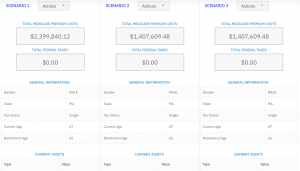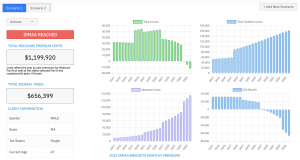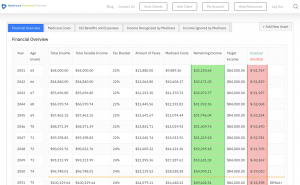Ever wondered why your Medicare premiums seem to inch up when you least expect it? Welcome to the world of what does IRMAA stand for. It’s not a secret society or a hidden code. Rather, it’s something that could be impacting your wallet right now without you even knowing. Imagine discovering an extra charge on your monthly bill—only this one doesn’t come with a straightforward explanation until you dig deeper.
IRMAA, standing tall as “Income-Related Monthly Adjustment Amount,” might sound benign. But don’t let its bureaucratic lullaby fool you; it plays a significant role in determining how much more than the standard premium high-income Medicare beneficiaries pay for Parts B and D. Did I mention that these determinations are based on your income from two years ago? Yes, what you earned then decides what you owe now.
Last year alone saw thresholds adjust dramatically – proving no one is immune to its reach. Yet here we are, most folks unaware of their potential rendezvous with IRMAA until they get hit. Navigating the financial landscape with awareness and foresight can shield us from unforeseen shocks.
Understanding IRMAA and Its Impact on Medicare Premiums
What Is IRMAA?
You’ve probably heard the term IRMAA thrown around when talking about Medicare, but what exactly is it? Let’s clear the air. IRMAA stands for “Income-Related Monthly Adjustment Amount.” Think of it as an extra slice you need to pay on top of your regular Medicare Part B and D premiums if you’re earning more dough than most.
How Is IRMAA Calculated?
The Social Security Administration (SSA) plays detective with your tax returns from two years ago to see if you fit into their bracket for paying this premium. Yep, they look at your adjusted gross income (AGI) and decide whether or not you owe a bit more each month for those essential health coverages under Medicare B and D plans.
This might make some wonder: Why peek into my finances from two years back? Well, that’s how SSA rolls – using historical data to predict current financial status. It feels like time travel without the cool gadgets.
Who Pays IRMAA?
- If rolling in higher incomes was part of your past couple of years’ narrative, chances are you’ll be nodding yes to this question.
- Paying IRMAA, then becomes part of ensuring everyone chips in fairly towards maintaining our healthcare safety net—especially if they can afford it.
- Sounds daunting? Maybe a little; but remember, less than 5% feel its impact directly – showing its tailored focus rather than broad stroke application.
In essence, understanding IRMAA’s calculation is pivotal since it affects how much cash leaves your pocket monthly towards healthcare once retirement sings its siren song. And who knows? With smart planning now, you could navigate away from being caught by surprise later down the line.
This pamphlet from Social Security tells us all we need to know about who ends up paying these additional premiums.
Remember folks, while we may not love every detail about managing healthcare costs as we age, understanding them sure does help make informed decisions. So let’s keep diving deeper together.
Key Takeaway:
IRMAA, or “Income-Related Monthly Adjustment Amount,” means paying extra on Medicare if you’re earning more. It’s decided by your income from two years ago and affects less than 5% of people. Knowing how it works helps manage healthcare costs smarter in retirement.
The Calculation of IRMAA for Medicare Beneficiaries
Factors Influencing IRMAA Calculation
Ever wondered why some folks pay more for their Medicare premiums? It’s all about the Income-Related Monthly Adjustment Amount, or IRMAA, a term that might sound like a distant relative but hits closer to home than you think. What causes the numbers to shift in this equation, then?
- Your yearly income: Yes, it boils down to your modified adjusted gross income (MAGI). The higher it is, the more you’re likely to fork over.
- Filing status: Whether you’re single or married filing jointly affects those thresholds too.
- Social Security Administration’s annual adjustments: Like clockwork, they tweak these numbers. Keeping an eye out helps.
Role of Modified Adjusted Gross Income in IRMAA
Ah yes, MAGI – not magic but sometimes feels just as complex. Here’s the scoop: Your MAGI from two years ago decides if you’ll be paying extra for prescription drug coverage. Picture this: You had a fantastic year financially (kudos.), but fast forward two years and voila – your Medicare premium could see an uptick because of that success. That’s right; Uncle Sam remembers.
MAGI includes everything from wages and dividends to capital gains and rental income – essentially all that jazz reported on your tax return with some add-backs like non-taxable Social Security benefits. And here’s where things get interesting; certain life changes can alter this course dramatically. Got divorced? Lost a job? These are moments when an appeal might make sense because let’s face it – who wants to pay more than they need to?
In essence, “it’s not just about what you earn now,” but rather “what did my finances look like back then?” This approach by the SSA ensures everyone pays their fair share based on past earnings – keeping Medicare robust for all beneficiaries.
Gearing up with knowledge about how IRMAA gets calculated gives power back into your hands — making sure surprises in mailboxes come only during birthdays or holidays. Now armed with insights into factors influencing MAGI and its significant role in determining those extra charges, managing healthcare costs doesn’t seem so daunting after all.
Key Takeaway:
Ever wondered why Medicare costs vary? It’s all about your income from two years back. Higher earnings mean higher premiums, thanks to IRMAA. Keep an eye on yearly adjustments and remember: big life changes could offer a chance to appeal those extra charges.
Appealing Your IRMAA Determination
Grounds for Appealing an IRMAA Decision
Got that notice saying you need to pay more for your Medicare because of IRMAA? It might feel like a punch in the gut, especially if it doesn’t seem right. Here’s the deal: mistakes happen. Maybe the Social Security Administration (SSA) used outdated or incorrect tax info. Or life threw you a curveball – think divorce, job loss, or any other event slashing your income.
Fortunately, you’re not without options when it comes to addressing this issue. You’re not stuck with this decision if it truly doesn’t reflect where you stand financially.
How to Submit an Appeal
The clock starts ticking once that letter hits your mailbox. You’ve got 60 days to challenge their call on your IRMAA determination. First step? Breathe. Next step? Gather evidence like there’s no tomorrow – we’re talking tax returns, letters showing income changes…the works.
- Pick up Form SSA-44: Grab this from the SSA website and fill it out with all those juicy details of why things are different now.
- Contact SSA: Ring them at 800-772-1213 or TTY: 800-325-0778 if speaking isn’t your thing.
- Show ’em what you’ve got: Send over Form SSA-44 along with any documents backing up your claim through snail mail or hand-deliver them to get things rolling faster.
Sit tight after that; they’ll review everything and let you know whether they agree with your appeal on paying higher premiums due to income-related monthly adjustment amounts (IRMAAs).
If this feels overwhelming, remember: deep breaths. With solid proof and a bit of patience, challenging an IRMAA determination is entirely within reach.
How Income Affects Your Medicare Costs Through IRMAA
Understanding the Link Between Income and Medicare Costs
You’ve worked hard your whole life, planning for those golden years. But here’s a twist – did you know that how much you pay for Medicare can actually hinge on your income? Yes, it’s true. And this is where IRMAA enters the picture.
IRMAA, or “Income-Related Monthly Adjustment Amount,” sounds like something out of a bureaucratic nightmare but stick with me. It’s pretty straightforward once you break it down.
If you’re bringing in what Uncle Sam considers ‘higher income,’ prepare to shell out more for parts B and D of your Medicare plan premium. That’s right; there’s a monthly adjustment based solely on your gross income from two years ago.
The idea behind IRMAA is simple: if you have the means, then chipping in a bit more helps keep Medicare strong for everyone. But let’s be real – finding out that crossing an arbitrary income threshold could bump up your costs isn’t exactly welcome news at any stage in life.
- Your monthly adjustment amount depends largely on your adjusted gross income (AGI), as reported on your IRS tax return from two years prior.
- A sudden jump into another bracket by just $1 can skyrocket premiums over $1,000/yearly.
- This especially stings if both spouses are enrolled in Medicare and filing jointly because guess what? Both premiums leap. Talk about doubling down…
To add some context here: As if managing retirement savings wasn’t enough fun already, now we’ve got to juggle our incomes carefully too?
The Social Security Administration sends notices if they decide it’s time for you to contribute more via IRMAA based on their calculations which – spoiler alert – doesn’t always make sense without diving deep into the specifics of these adjustments.
All things considered though, while paying extra might not sound thrilling, understanding why and how these charges apply gives us back some control over our financial health care planning during retirement. Because after all, who doesn’t love having control…especially when it comes to money matters?
Key Takeaway:
Understanding IRMAA is key to managing Medicare costs in retirement. Your income dictates your premiums, and crossing into a higher bracket can lead to significant increases. Staying informed gives you control over your financial health care planning.
Strategies to Minimize the Impact of IRMAA on Your Finances
Planning Ahead to Manage or Reduce IRMAA Charges
Let’s face it, nobody likes surprises when they come in the form of extra charges. Especially not from something as crucial as Medicare premiums. But here’s a little secret: With some savvy planning, you can actually manage or even reduce those pesky IRMAA charges. Yes, you heard that right.
The key? Understanding how your income today affects what you’ll pay tomorrow. It sounds simple but stick with me.
- Tax Planning: Start by getting cozy with your tax situation. Remember, IRMAA looks at your income from two years back. So any moves you make now could help lower what you owe later down the line.
- Savings Strategies: Next up is rethinking where and how you save. Contributing more to tax-deferred accounts like traditional IRAs might just be your ticket to keeping under those IRMAA thresholds.
- Roth Conversions: Speaking of savings strategies…ever thought about Roth conversions? This move requires paying taxes now for tax-free withdrawals later—potentially keeping your future MAGI (Modified Adjusted Gross Income) in check.
- Leverage Life Changes: Had a major life event recently? Things like marriage, divorce, or losing a job impact your income and possibly your IRMAA status too. Don’t miss out on appealing if life throws curveballs at ya.
All these tactics revolve around one golden rule: stay informed about both changes in Medicare rules and shifts in personal finances through diligent financial planning and health insurance know-how. Keeping an eye on these factors is crucial.
You don’t have to go it alone either. There are resources galore – think Medicare savings programs, for starters—that offer guidance and help slash those costs even further because let’s be honest; we’d all rather spend our hard-earned dough on fun stuff than premium surcharges.
Key Takeaway:
Get ahead of IRMAA charges by understanding how today’s income impacts tomorrow’s Medicare premiums. Dive into tax planning, save smartly, consider Roth conversions, and don’t miss appealing during life changes. Stay sharp on Medicare rules and personal finance shifts to keep those extra charges at bay.
Navigating the Complexities of Medicare Part B and D with Respect to IRMAA
The Specifics of Part B and Part D Affected by IRMAA
So, you’ve been hit with an IRMAA on your Medicare Part D drug coverage costs, or maybe it’s your Medicare Part B that’s feeling a bit heavier. What gives? Let me break it down for you.
First off, what is this mysterious IRMAA? It stands for Income-Related Monthly Adjustment Amount. Yep, as if Medicare wasn’t complicated enough. But here’s the deal: If you’re rocking a higher income, Uncle Sam says you can chip in a bit more for your health care.
- Medicare Part B: This part covers things like doctor visits and outpatient services. Got hit with an IRMAA here? It means your premium just got bumped up because of your income level.
- Medicare Part D: This one deals with prescription drugs. Similar story – if you’re paying an IRMAA on this front, it’s because those tax returns showed some pretty numbers.
This whole situation might make you feel like tossing all those IRS letters into the ocean but hang tight. There’s hope yet. You see, these adjustments are based on past earnings – specifically from two years ago. Policy changes can affect this.
You might be thinking – “But wait. My financial situation has changed.” Good news: You can appeal this decision. Whether life threw at you retirement party confetti or unexpected curveballs changing your cash flow; there’s room to explain that to SSA (Social Security Administration).
Breathe easy knowing every year rolls around as another chance at adjustment based on new income reports. So while today may have its challenges navigating through Medicare’s alphabet soup spiced up with some extra acronyms thanks to high incomes; tomorrow could bring smoother sailing waters where premiums adjust back down again after waves settle. In other words, keep tabs not only on health needs but also financial shifts.
Key Takeaway:
Feeling the weight of IRMAA on your Medicare? It’s all about income. High earners pay more for Part B and D, but you can appeal if your finances change. Keep an eye on income shifts to potentially lower future premiums.
The Evolution of Medicare’s Income-Related Surcharges Over Time
Historical Changes in Medicare’s Approach to High-Income Beneficiaries
Oh, how times have changed. When it comes to the way high-income beneficiaries are treated by Medicare, we’ve seen quite the evolution. Let’s dive into a little history lesson, shall we?
Back in 2007, the landscape shifted dramatically for Medicare Part B. For the first time ever, if you were rolling in more dough than average Joe or Jane, you’d start paying more for your premiums. Fast forward four years and bam – those with thicker wallets also had to fork out extra bucks for their Part D prescription drug coverage.
- In 2007: IRMAA (Income-Related Monthly Adjustment Amount) kicks off with higher premiums on Part B based on income.
- In 2011: The rules extend to include Part D premiums too. Now both parts of Medicare could see an uptick depending on what’s sitting pretty in your bank account.
It wasn’t merely a matter of nudging the wealthier individuals to contribute slightly more; this strategy was intricately connected to larger schemes designed to fortify and sustain the program for future generations. Because let’s face it – everyone wants Medicare around when they need it.
A few numbers? Sure thing. Initially set at $80k for individuals and $160k for couples filing jointly back when this all started; these thresholds have been nudging upwards almost as steadily as Netflix subscription prices (CMS details here). But unlike our streaming services which cost us mere entertainment value when prices rise, these changes directly impact people’s pockets regarding healthcare access – something far from entertaining if you ask me.
Cut through today; there are detailed tables that lay out exactly where each dollar threshold stands every year so there can be no confusion about who pays what. And yet – surprises still happen because remember – they’re basing this stuff on tax returns from two years ago. So maybe last year was great financially but now? Not so much… Oops.
If anything though – learning about IRMAA teaches us one important life skill: Always keep an eye out ahead while navigating financial waters… especially when sailing near government-run programs like Medicare.
Key Takeaway:
Medicare’s approach to high-income beneficiaries has evolved, introducing IRMAA for Part B in 2007 and extending it to Part D in 2011. This move aimed at maintaining the program’s stability by adjusting premiums based on income, affecting healthcare access directly.
Key Documents and Information Needed for an Effective IRMAA Appeal
Preparing Your Case for an Appeal
So, you’ve just opened your mailbox to find a notice that you’re on the hook for paying more in Medicare premiums due to the Income-Related Monthly Adjustment Amount (IRMAA). Suddenly, you’re hit with the realization that your expenses are about to skyrocket, aren’t you? But here’s where we roll up our sleeves. An effective appeal isn’t just about crossing fingers; it’s about arming yourself with the right ammo.
Gather Those Tax Returns:
- The cornerstone of your IRMAA appeal will be your tax returns. Specifically, we’re talking about those filed jointly or individually in years prior. Your tax documents are key as they illustrate your fiscal landscape during the period SSA examined to assess your IRMAA surcharge.
- If there’s been a significant change in income since then — say goodbye job or hello retirement — these forms become even more pivotal.
Why Years Prior Matter:
You might wonder why SSA is thumbing through old chapters of your financial life story. Well, SSA uses income data from two years ago to decide if you need to pay extra premiums today. Seems odd? Odd as it might seem, understanding that the SSA bases its decisions on income data from two years prior arms us with the precise knowledge we need to bolster our argument should we choose to challenge their verdict.
Form SSA-44, remember this number. Consider this form as your secret spell for making those pesky extra charges vanish, especially when life’s shifts affect your wallet.
- Lost employment?
- Said “I do” or signed divorce papers?
- Bid farewell to a spouse?
All these scenarios qualify as reasons why last year’s jeans don’t fit anymore—figuratively speaking—and they’re all valid grounds for requesting reconsideration from SSA regarding IRMAA charges.
Last but not least: patience and persistence are virtues here. The appeals process may feel longer than waiting at DMV without an appointment – agonizingly slow. However, once armed with correct paperwork and solid evidence supporting changes in circumstances or errors within initial calculations… victory could well be yours.
Key Takeaway:
Ready to tackle that IRMAA notice? Arm yourself with past tax returns and Form SSA-44. They’re your best shot at proving why you shouldn’t pay more for Medicare. Remember, changes like retirement or divorce are key in this battle. Stay patient, stay persistent.
Conclusion
So, we’ve peeled back the layers on what does irmaa stand for and its sneaky way of sliding into your Medicare costs. IRMAA, or Income-Related Monthly Adjustment Amount, isn’t just a bunch of letters; it’s a reality check from two years ago determining how much more you’ll be paying now. Surprised? You shouldn’t be.
Our exploration revealed that preemptively monitoring our earnings and comprehending their immediate influence on forthcoming costs is crucial, as unexpected fees are universally unwelcome. We also learned that there are ways to challenge IRMAA if it doesn’t quite fit our situation today versus two years ago.
The bottom line here is awareness and preparation can save us from financial headaches later. It’s all about planning smarter to manage or even reduce those unexpected bumps in the road like IRMAA charges. So yes, while discovering this might feel like uncovering hidden treasure (or maybe more accurately, hidden fees), knowledge is power—especially when it comes to navigating the murky waters of Medicare premiums.
We didn’t just crack open the code behind IRMAA; we armed ourselves with strategies to potentially soften its blow on our finances. Bear in mind, every nugget of wisdom aids in charting a course for more tranquil financial voyages.
Table of Contents:
- Understanding IRMAA and Its Impact on Medicare Premiums
- The Calculation of IRMAA for Medicare Beneficiaries
- Appealing Your IRMAA Determination
- How Income Affects Your Medicare Costs Through IRMAA
- Strategies to Minimize the Impact of IRMAA on Your Finances
- Navigating the Complexities of Medicare Part B and D with Respect to IRMAA
- The Evolution of Medicare’s Income-Related Surcharges Over Time
- Key Documents and Information Needed for an Effective IRMAA Appeal
- Conclusion
Streamlining the Medicare Surcharge Calculation Process.
Our Healthcare Retirement Planner software is designed to streamline the retirement planning process for financial professionals. By providing an efficient way to calculate IRMAA costs, our tool helps you save time and focus on other aspects of your clients’ retirement plans.
- Faster calculations: Our software quickly calculates IRMAA costs based on your client’s income and tax filing status, eliminating manual calculations and potential errors.
- User-friendly interface: The intuitive design of our platform makes it easy for financial professionals to input data and generate results with minimal effort.
- Data integration: Seamlessly integrate our calculator into your existing financial planning tools or CRM systems for a more streamlined workflow.
- Easy to Understand Reports: Export reports to easily share with your clients
- Tax and Surcharge Modeling: see how different types of income affects both taxes and your surcharges.
In addition to simplifying the calculation process, using our Healthcare Retirement Planner can also help improve communication between you and your clients. With clear visuals that illustrate how IRMAA costs impact their overall retirement plan, you can effectively convey complex information in an easily digestible format. This enables clients to make informed decisions about their healthcare expenses during retirement while ensuring they are prepared for any potential changes in Medicare premiums due to income fluctuations. To learn more about how our software can benefit both you as a financial professional and your clients’ retirement planning experience, visit the features page. Streamlining retirement planning processes can help financial professionals save time and resources, allowing them to focus on other areas of their clients’ needs. Automated calculation of IRMAA costs is the next step in streamlining this process even further.





